The Effects of Climate Variation and Anthropogenic Activity on Karst Spring Discharge Based on the Wavelet Coherence Analysis and the Multivariate Statistical
Abstract
1. Introduction
2. Study Area and Data
2.1. Site Description
2.2. Data Sources
3. Methods
3.1. Principal Component Analysis (PCA)
3.2. Cluster Analysis and the Significance Test
3.3. Continuous Wavelet Transform (CWT)
3.4. Wavelet Coherence
3.5. Global Coherence
3.6. Non-Stationary General Extreme Value (NSGEV) Distribution
4. Results and Discussion
4.1. PCA of Precipitation Dataset
4.2. The Spring Discharge Segment and the Significant Test
4.3. Evaluation of the Reduction in Spring Discharge Attributable to Human Activity
4.4. CWT of the Climate Phenomenon, Precipitation and the Spring Discharge
4.5. Wavelet Coherence of Precipitation and Spring Discharge with ISM
4.6. Wavelet Coherence of Precipitation and Spring Discharge with EASM
4.7. Wavelet Coherence of Precipitation and Spring Discharge with ENSO
4.8. Wavelet Coherence of Precipitation and Spring Discharge with PDO
4.9. NSGEV for the Spring Discharge Minima
5. Conclusions
Author Contributions
Funding
Informed Consent Statement
Data Availability Statement
Acknowledgments
Conflicts of Interest
References
- Panno, S.V.; Kelly, W.R.; Scott, J.; Zheng, W.; McNeish, R.E.; Holm, N.; Hoellein, T.J.; Baranski, E.L. Microplastic Contamination in Karst Groundwater Systems. Ground Water 2019, 57, 189–196. [Google Scholar] [CrossRef]
- Kovačič, G.; Petrič, M.; Ravbar, N. Evaluation and Quantification of the Effects of Climate and Vegetation Cover Change on Karst Water Sources: Case Studies of Two Springs in South-Western Slovenia. Water 2020, 12, 3087. [Google Scholar] [CrossRef]
- Zhang, L.; Qin, X.; Tang, J.; Liu, W.; Yang, H. Review of arsenic geochemical characteristics and its significance on arsenic pollution studies in karst groundwater, Southwest China. Appl. Geochem. 2017, 77, 80–88. [Google Scholar] [CrossRef]
- Xu, Z.; Hu, B.X.; Xu, Z.; Wu, X. Numerical study of groundwater flow cycling controlled by seawater/freshwater interaction in Woodville Karst Plain. J. Hydrol. 2019, 579, 124171. [Google Scholar] [CrossRef]
- Jimenez-Martinez, J.; Smith, M.; Pope, D. Prediction of groundwater-induced flooding in a chalk aquifer for future climate change scenarios. Hydrol. Process. 2016, 30, 573–587. [Google Scholar] [CrossRef]
- Charlier, J.; Ladouche, B.; Maréchal, J. Identifying the impact of climate and anthropic pressures on karst aquifers using wavelet analysis. J. Hydrol. 2015, 523, 610–623. [Google Scholar] [CrossRef]
- Fiorillo, F.; Petitta, M.; Preziosi, E.; Rusi, S.; Esposito, L.; Tallini, M. Long-term trend and fluctuations of karst spring discharge in a Mediterranean area (central-southern Italy). Environ. Earth Sci. 2015, 74, 153–172. [Google Scholar] [CrossRef]
- Schiperski, F.; Zirlewagen, J.; Hillebrand, O.; Nödler, K.; Licha, T.; Scheytt, T. Relationship between organic micropollutants and hydro-sedimentary processes at a karst spring in south-west Germany. Sci. Total Environ. 2015, 532, 360–367. [Google Scholar] [CrossRef]
- Huo, X.; Liu, Z.; Duan, Q.; Hao, P.; Zhang, Y.; Hao, Y.; Zhan, H. Linkages between Large-Scale Climate Patterns and Karst Spring Discharge in Northern China. J. Hydrometeorol. 2015, 17, 713–724. [Google Scholar] [CrossRef]
- Yuan, D. Karstology of China; Geological Publishing House: Beijing, China, 1994. (In Chinese) [Google Scholar]
- Suksi, J.; Tullborg, E.-L.; Pidchenko, I.; Krall, L.; Sandström, B.; Kaksonen, K.; Vitova, T.; Kvashnina, K.O.; Göttlicher, J. Uranium remobilisation in anoxic deep rock-groundwater system in response to late Quaternary climate changes—Results from Forsmark, Sweden. Chem. Geol. 2021, 584, 120551. [Google Scholar] [CrossRef]
- Rezaei, A.; Gurdak, J.J. Large-scale climate variability controls on climate, vegetation coverage, lake and groundwater storage in the Lake Urmia watershed using SSA and wavelet analysis. Sci. Total Environ. 2020, 724, 138273. [Google Scholar] [CrossRef] [PubMed]
- Gumuła-Kawęcka, A.; Jaworska-Szulc, B.; Szymkiewicz, A.; Gorczewska-Langner, W.; Angulo-Jaramillo, R.; Šimůnek, J. Impact of climate change on groundwater recharge in shallow young glacial aquifers in northern Poland. Sci. Total Environ. 2023, 877, 162904. [Google Scholar] [CrossRef]
- Tremblay, L.; Larocque, M.; Anctil, F.; Rivard, C. Teleconnections and interannual variability in Canadian groundwater levels. J. Hydrol. 2011, 410, 178–188. [Google Scholar] [CrossRef]
- Saber, A.; Cheng, V.Y.S.; Arhonditsis, G.B. Evidence for increasing influence of atmospheric teleconnections on water levels in the Great Lakes. J. Hydrol. 2023, 616, 128655. [Google Scholar] [CrossRef]
- Zhang, J.; Hao, Y.; Hu, B.X.; Huo, X.; Hao, P.; Liu, Z. The effects of monsoons and climate teleconnections on the Niangziguan Karst Spring discharge in North China. Clim. Dyn. 2017, 48, 53–70. [Google Scholar] [CrossRef]
- Hao, Y.H.; Zhang, J.; Wang, J.J.; Li, R.F.; Hao, P.M.; Zhan, H.B. How does the anthropogenic activity affect the spring discharge? J. Hydrol. 2016, 540, 1053–1065. [Google Scholar] [CrossRef]
- Song, X.; Hao, H.; Liu, W.; Wang, Q.; An, L.; Jim Yeh, T.-C.; Hao, Y. Spatial-temporal behavior of precipitation driven karst spring discharge in a mountain terrain. J. Hydrol. 2022, 612, 128116. [Google Scholar] [CrossRef]
- Liang, Y.; Wang, W.; Zhao, C.; Wang, W.; Tang, C. Karst water variation characteristics and environmental problems in northern China. Ankengsin Karst China 2013, 32, 34–42. (In Chinese) [Google Scholar]
- Shekhar, M.; Sharma, A.; Dimri, A.P.; Tandon, S.K. Asian summer monsoon variability, global teleconnections, and dynamics during the last 1000 years. Earth-Sci. Rev. 2022, 230, 104041. [Google Scholar] [CrossRef]
- Liu, Y.; Liang, P.; Sun, Y. Chapter 8—Northern Teleconnection between the Indian Summer Monsoon and Rainfall Anomalies in Northern China. In The Asian Summer Monsoon; Elsevier: Amsterdam, The Netherlands, 2019; pp. 135–155. [Google Scholar]
- Hau, N.-X.; Sano, M.; Nakatsuka, T.; Chen, S.-H.; Chen, I.C. The modulation of Pacific Decadal Oscillation on ENSO-East Asian summer monsoon relationship over the past half-millennium. Sci. Total Environ. 2023, 857, 159437. [Google Scholar] [CrossRef]
- Fu, S.; Zhang, H.; Zhong, Q.; Chen, Q.; Liu, A.; Yang, J.; Pang, J. Spatiotemporal variations of precipitation concentration influenced by large-scale climatic factors and potential links to flood-drought events across China 1958–2019. Atmos. Res. 2023, 282, 106507. [Google Scholar] [CrossRef]
- Niu, T.; Wang, J.; Yang, Y.; Jiang, X.; Jiang, Y.; Che, H. The impact of the large-scale circulation anomalies in the northern hemisphere on air quality in Wuhan of China during the Spring Festival in 2020. J. Atmos. Sol. Terr. Phys. 2022, 238–239, 105931. [Google Scholar]
- An, L.; Hao, Y.; Yeh, T.-C.J.; Liu, Y.; Liu, W.; Zhang, B. Simulation of karst spring discharge using a combination of time–frequency analysis methods and long short-term memory neural networks. J. Hydrol. 2020, 589, 125320. [Google Scholar] [CrossRef]
- Han, X.; Lu, R.; Li, Q. Karst Water Systems: A Study on Big Karst Spring in Shanxi; Geological Publishing House: Beijing, China, 1993. (In Chinese) [Google Scholar]
- Hu, C.; Hao, Y.; Yeh, T.C.J.; Pang, B.; Wu, Z. Simulation of spring flows from a karst aquifer with an artificial neural network. Hydrol. Process. 2008, 22, 596–604. [Google Scholar] [CrossRef]
- Liang, Y.; Gao, H.; Zhang, J.; Huo, J.; Wang, T. Preliminary quantitative analysis on the causes of discharge attenuation in Niangziguan spring. Carsologica Sin. 2005, 24, 227–231. (In Chinese) [Google Scholar]
- Yuan, R.; Li, Z.; Guo, S. Health risks of shallow groundwater in the five basins of Shanxi, China: Geographical, geological and human activity roles. Environ. Pollut. 2023, 316, 120524. [Google Scholar] [CrossRef]
- Fan, Y.; Huo, X.; Hao, Y.; Liu, Y.; Wang, T.; Liu, Y.; Yeh, T.J. An assembled extreme value statistical model of karst spring discharge. J. Hydrol. 2013, 504, 57–68. [Google Scholar] [CrossRef]
- Zhang, H.; Guo, Y.; Miu, P.; Sun, K. Analysis on the status of water ecological investigation in Niangziguan spring area and the cause of spring discharge attenuation. China Environ. Sci. Soc. Acad. Essays 2014. (In Chinese) [Google Scholar]
- Fotsing, C.; Menadjou, N.; Bobda, C. Iterative closest point for accurate plane detection in unorganized point clouds. Autom. Constr. 2021, 125, 103610. [Google Scholar] [CrossRef]
- Takio, K. Principal component analysis (PCA). In Computer Vision; Katsushi, I., Ed.; Springer: New York, NY, USA, 2014; pp. 636–639. [Google Scholar]
- Yeh, Y.-C.; Wu, H.-A.; Huang, F. Exploring profiles of varied types of achievement goals, emotions and digital insight problem solving through cluster analysis. Think. Skills Creat. 2022, 46, 101170. [Google Scholar] [CrossRef]
- Asmita, R.M.; Dhyan, S.A. Trend and periodicity analysis in rainfall pattern of Nira Basin, Central India. Am. J. Clim. 2014, 3, 60–70. [Google Scholar]
- Zhang, Y.; Wang, M.; Zipperle, M.; Abbasi, A.; Tani, M. RelRank: A relevance-based author ranking algorithm for individual publication venues. Inf. Process. Manag. 2023, 60, 103156. [Google Scholar] [CrossRef]
- Dao, P.B. On Wilcoxon rank sum test for condition monitoring and fault detection of wind turbines. Appl. Energy 2022, 318, 119209. [Google Scholar] [CrossRef]
- Yan, Y.; Li, J.; Huai, N.; Guan, J.; Liu, H. Two-station analysis of passive surface waves with continuous wavelet transform and plane-wave-based beamforming. J. Appl. Geophys. 2022, 197, 104526. [Google Scholar] [CrossRef]
- Kriechbaumer, T.; Angus, A.; Parsons, D.; Casado, M.R. An improved wavelet-ARIMA approach for forecasting metal prices. Resour. Policy 2014, 39, 32–41. [Google Scholar] [CrossRef]
- Torrence, C.; Compo, G.P. A practical guide to wavelet analysis. Bullet. Am. Meteorol. Soc. 1998, 79, 61–78. [Google Scholar] [CrossRef]
- Abebe, S.A.; Qin, T.; Zhang, X.; Yan, D. Wavelet transform-based trend analysis of streamflow and precipitation in Upper Blue Nile River basin. J. Hydrol. Reg. Stud. 2022, 44, 101251. [Google Scholar] [CrossRef]
- Pagliaroli, T.; Gambioli, F.; Saltari, F.; Cooper, J. Proper orthogonal decomposition, dynamic mode decomposition, wavelet and cross wavelet analysis of a sloshing flow. J. Fluids Struct. 2022, 112, 103603. [Google Scholar] [CrossRef]
- Liu, Y.; Hao, Y.; Fan, Y.; Wang, T.; Huo, X.; Liu, Y.; Yeh, T.J. A nonstationary extreme value distribution for analyzing the cessation of karst spring discharge. Hydrol. Process. 2014, 28, 5251–5258. [Google Scholar] [CrossRef]
- Coles, S. An Introduction to Statistical Modeling of Extreme Values; Springer: New York, NY, USA, 2001. [Google Scholar]
- Magee, L. Nonlocal behavior in polynomial regressions. The American Statistician. Am. Stat. Assoc. 1998, 52, 20–22. [Google Scholar]
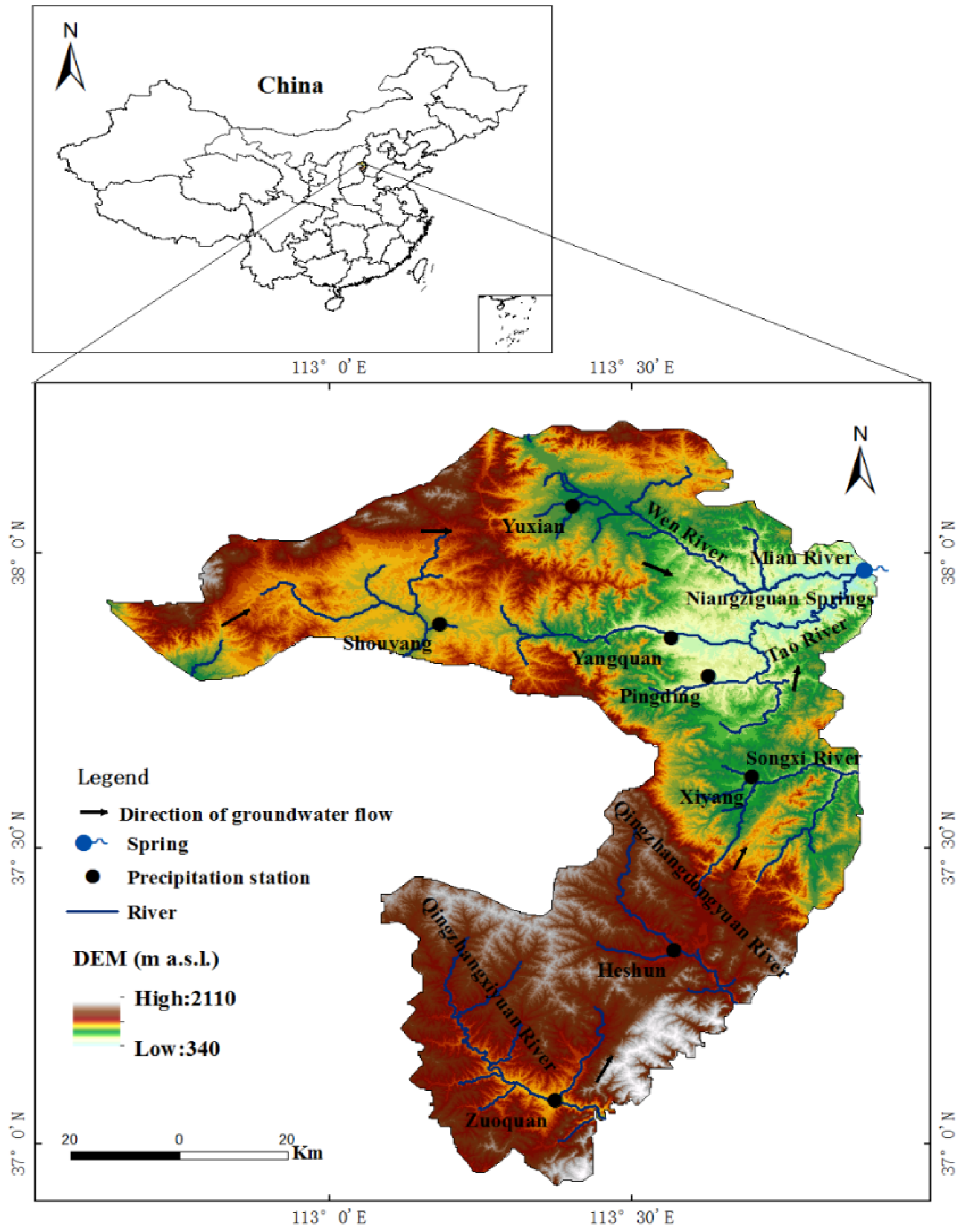
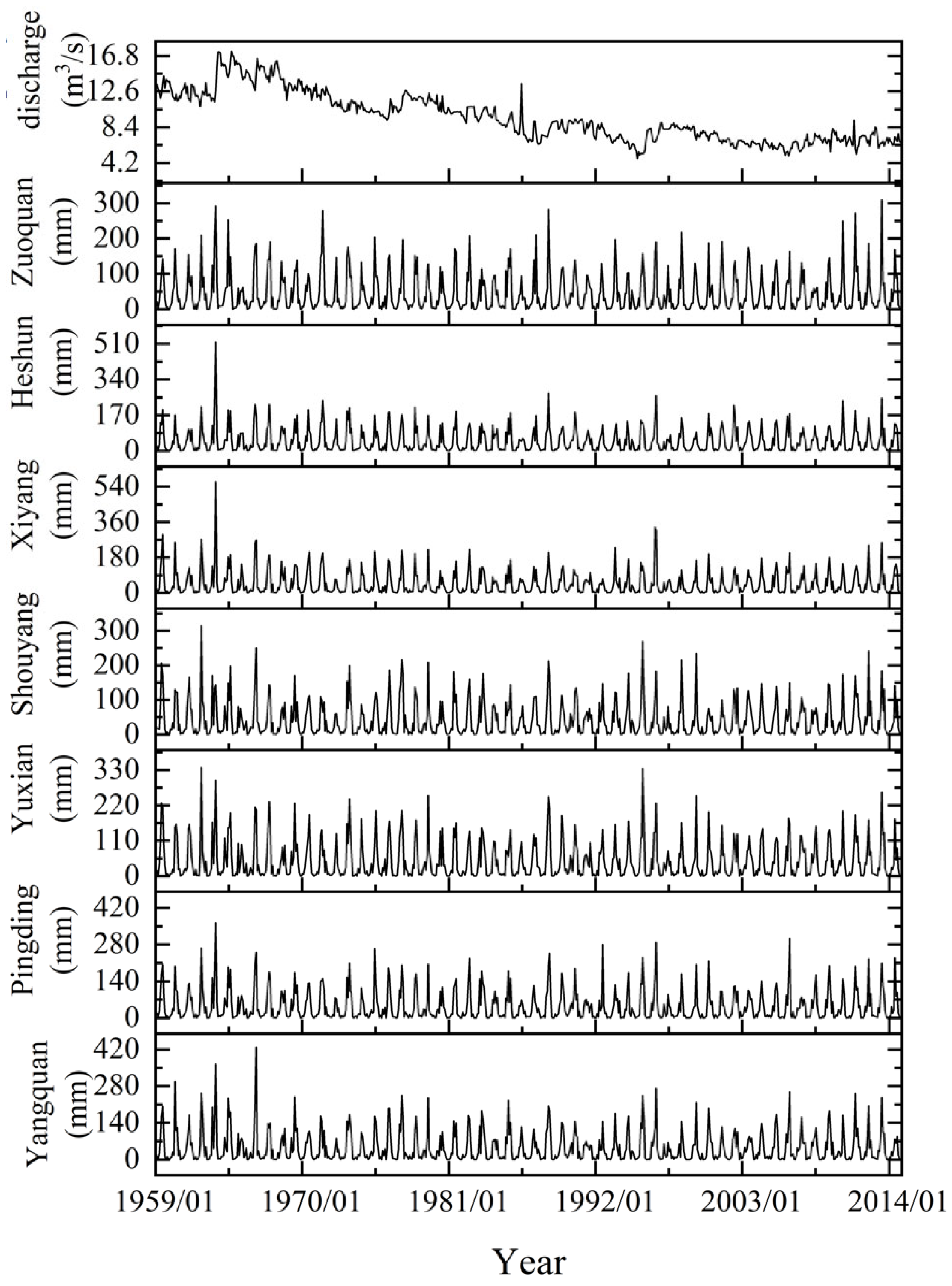
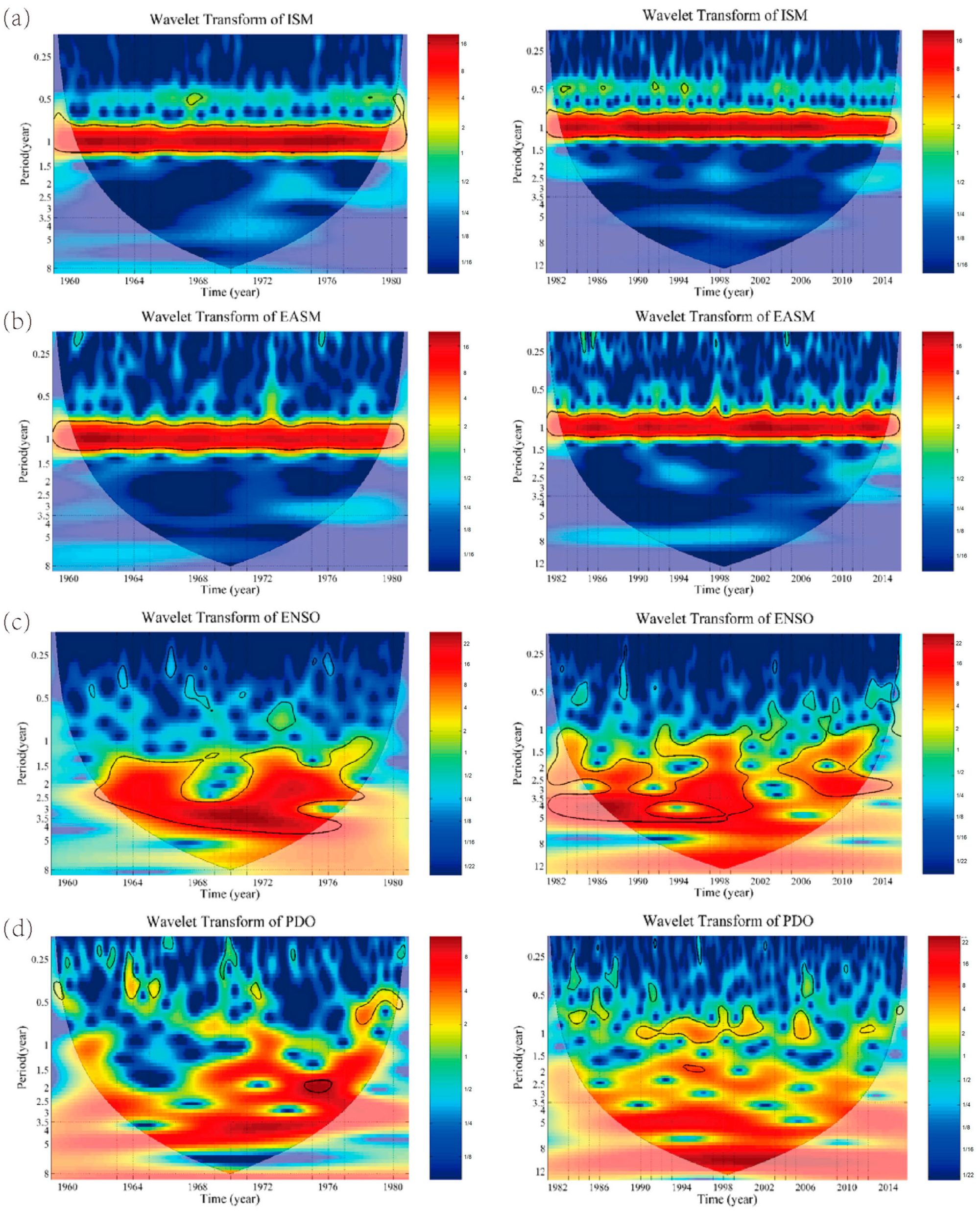
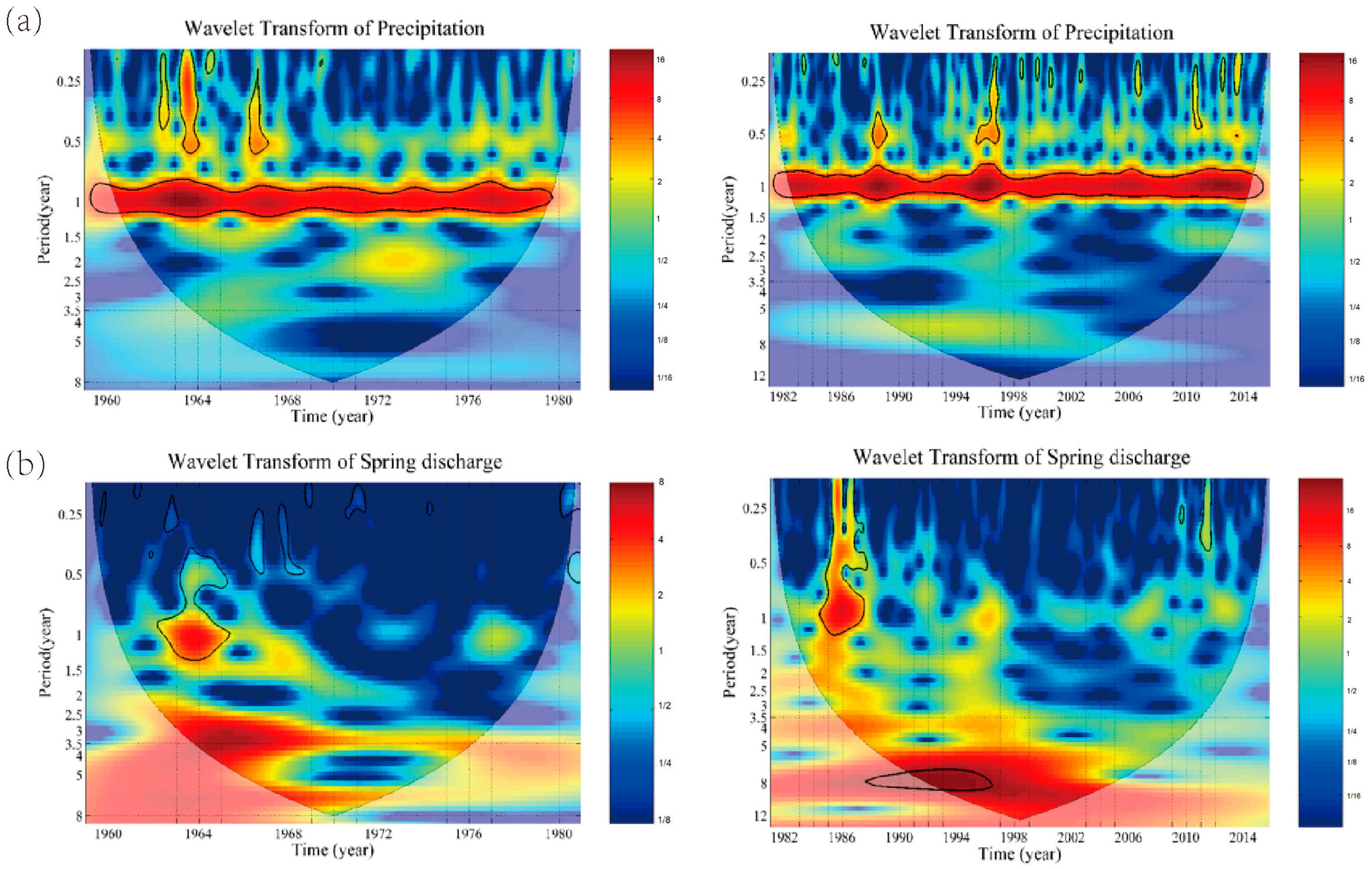
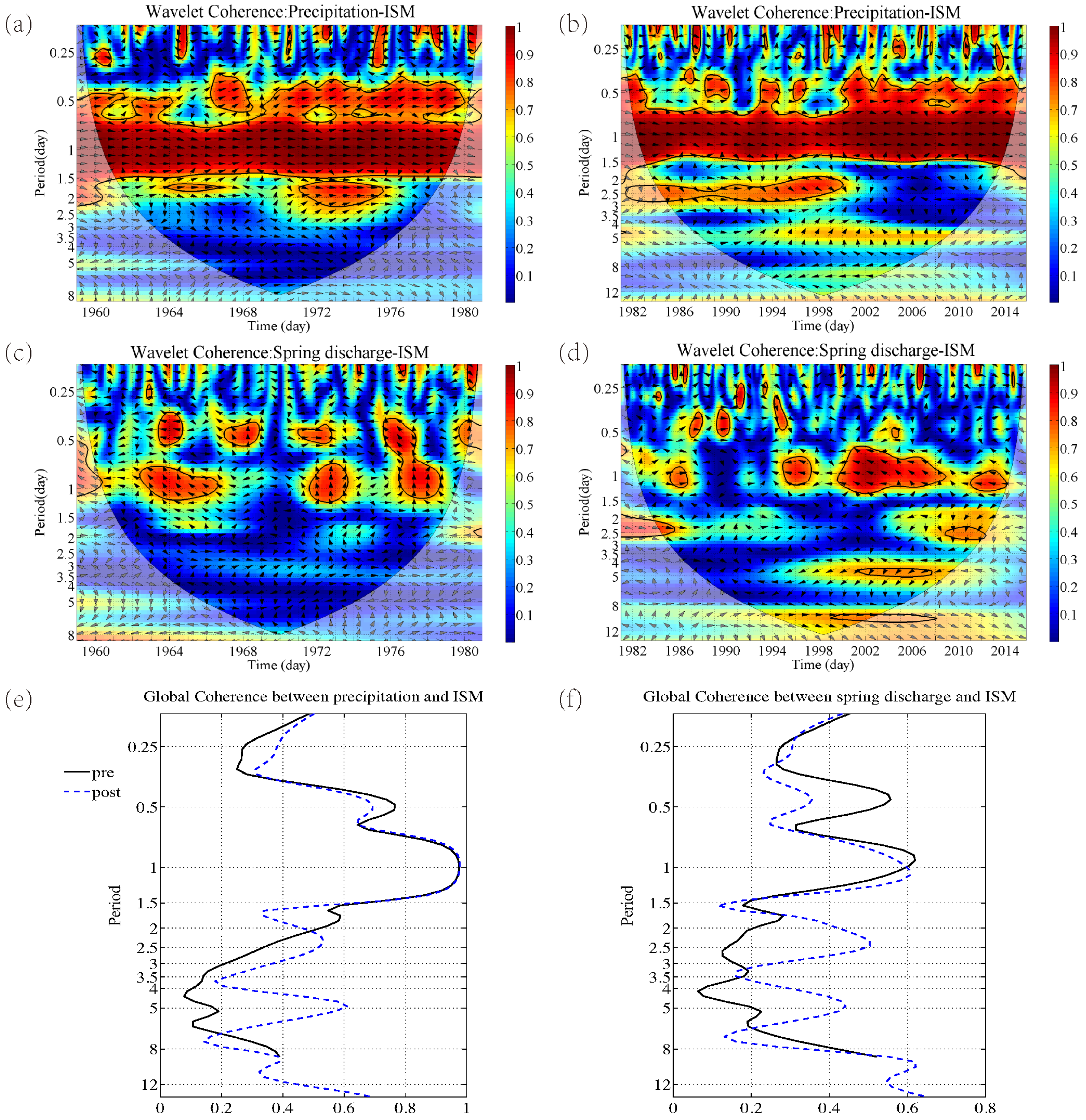

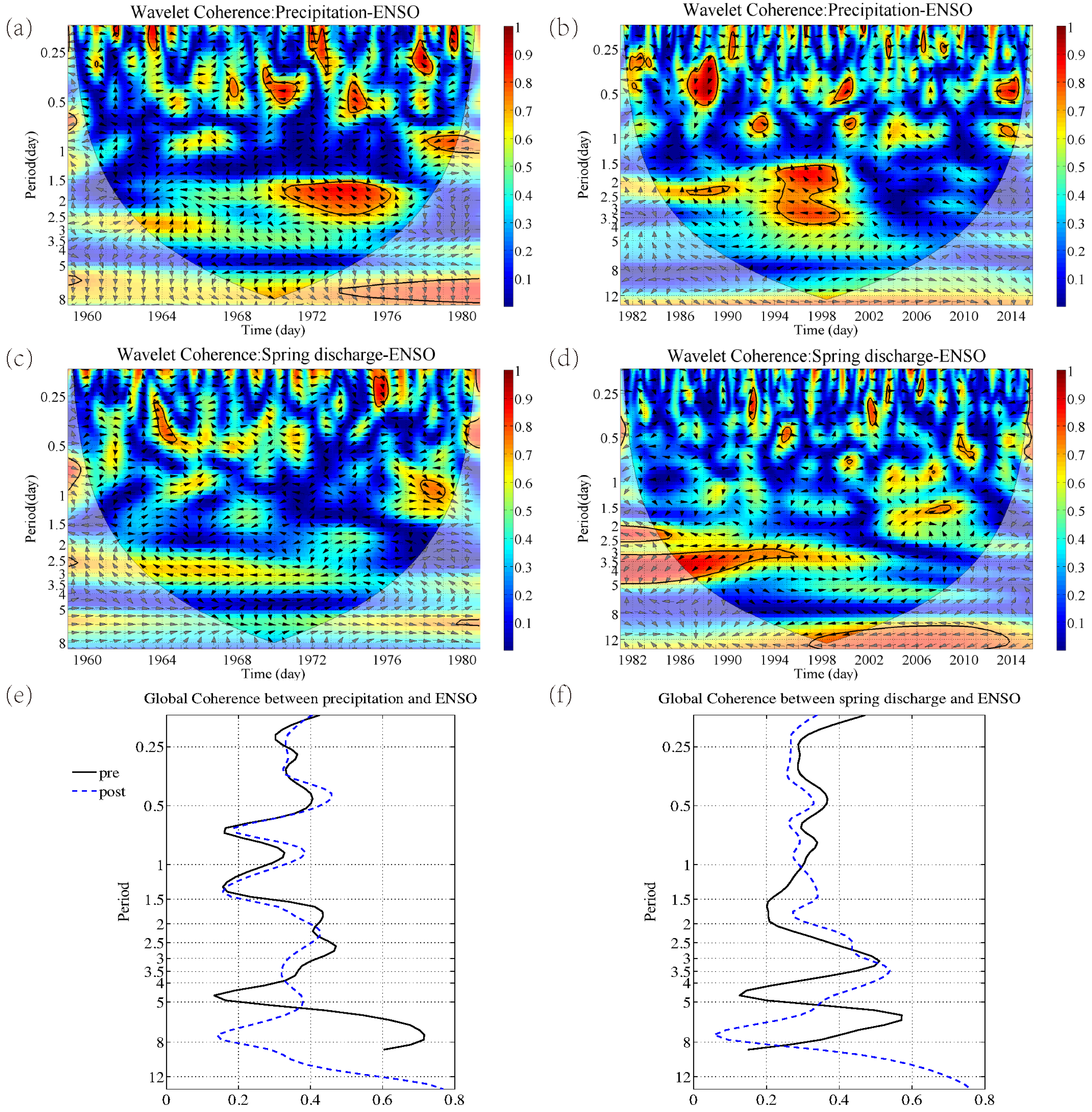
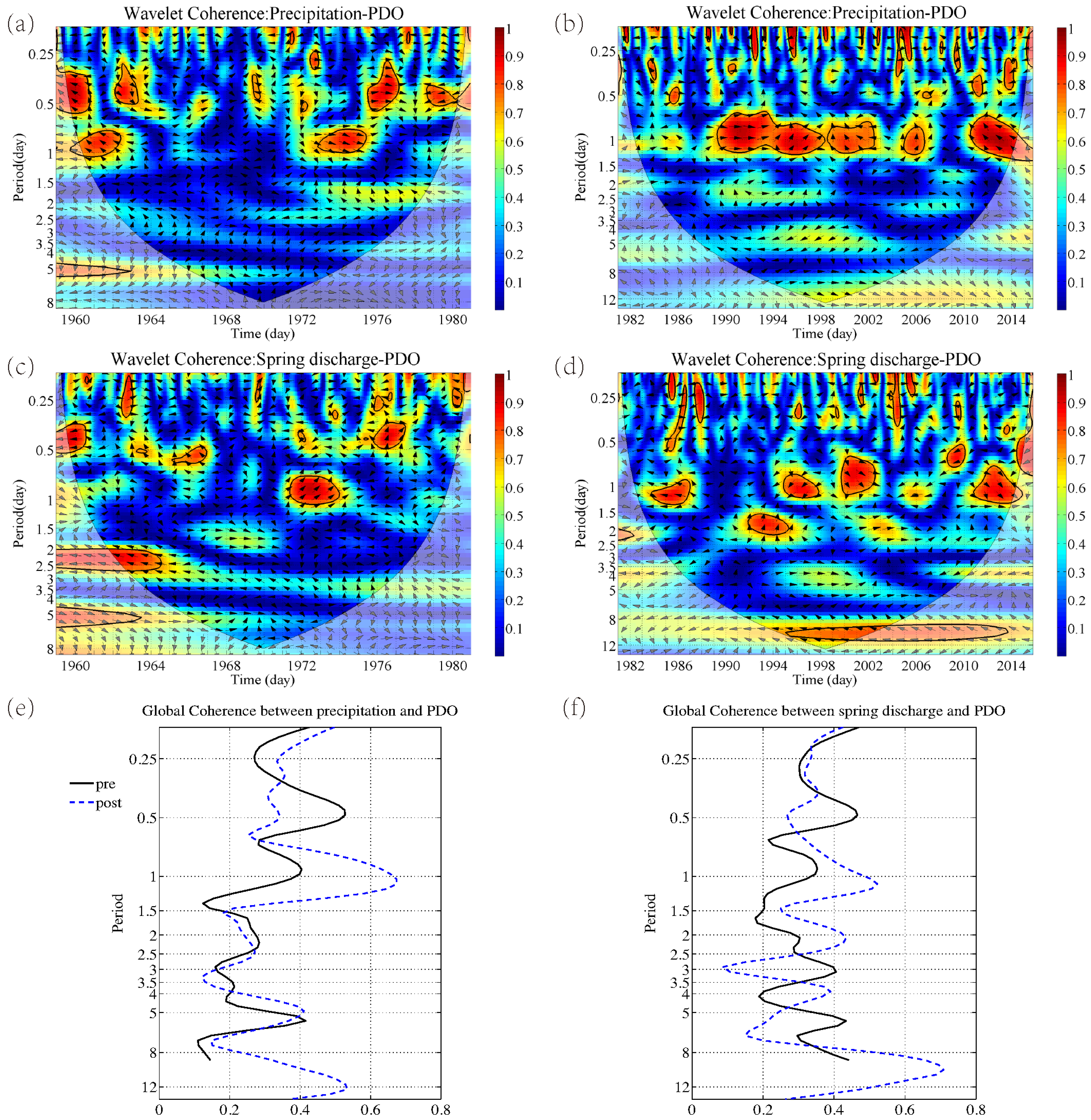
| Principal Components | Latents | Variance Proportion (%) |
|---|---|---|
| Y1 | 17,083 | 90.29 |
| Y2 | 800 | 4.23 |
| Y3 | 451 | 2.38 |
| Y4 | 238 | 1.25 |
| Y5 | 198 | 1.05 |
| Y6 | 151 | 0.80 |
| Indices | Pre-Development | Post-Development |
|---|---|---|
| ISM | 1 | 1 |
| EASM | 1 | 1 |
| ENSO | 1–5 | 1–5 |
| PDO | 0.25–0.5 | 0.5 and 1 |
| Precipitation | 0.25–0.5 and 1 | 0.25–0.5 and 1 |
| Spring discharge | 0.25–1 | 0.25–1 |
| Year | Observed Spring Discharge Minima | Predicted Values | 95% Confidential Intervals | |
|---|---|---|---|---|
| Upper Boundary | Lower Boundary | |||
| 2013 | 5.96 | 5.20 | 6.73 | 3.47 |
| 2014 | 6.29 | 5.10 | 6.64 | 3.37 |
| 2015 | 5.81 | 5.00 | 6.54 | 3.27 |
| 2016 | 4.91 | 6.45 | 3.18 | |
| 2017 | 4.82 | 6.35 | 3.09 | |
| 2018 | 4.72 | 6.26 | 2.99 | |
| 2019 | 4.62 | 6.16 | 2.90 | |
| 2020 | 4.53 | 6.07 | 2.80 | |
Disclaimer/Publisher’s Note: The statements, opinions and data contained in all publications are solely those of the individual author(s) and contributor(s) and not of MDPI and/or the editor(s). MDPI and/or the editor(s) disclaim responsibility for any injury to people or property resulting from any ideas, methods, instructions or products referred to in the content. |
© 2023 by the authors. Licensee MDPI, Basel, Switzerland. This article is an open access article distributed under the terms and conditions of the Creative Commons Attribution (CC BY) license (https://creativecommons.org/licenses/by/4.0/).
Share and Cite
Zhang, J.; Zhu, Z.; Hao, H. The Effects of Climate Variation and Anthropogenic Activity on Karst Spring Discharge Based on the Wavelet Coherence Analysis and the Multivariate Statistical. Sustainability 2023, 15, 8798. https://doi.org/10.3390/su15118798
Zhang J, Zhu Z, Hao H. The Effects of Climate Variation and Anthropogenic Activity on Karst Spring Discharge Based on the Wavelet Coherence Analysis and the Multivariate Statistical. Sustainability. 2023; 15(11):8798. https://doi.org/10.3390/su15118798
Chicago/Turabian StyleZhang, Juan, Zhongli Zhu, and Huiqing Hao. 2023. "The Effects of Climate Variation and Anthropogenic Activity on Karst Spring Discharge Based on the Wavelet Coherence Analysis and the Multivariate Statistical" Sustainability 15, no. 11: 8798. https://doi.org/10.3390/su15118798
APA StyleZhang, J., Zhu, Z., & Hao, H. (2023). The Effects of Climate Variation and Anthropogenic Activity on Karst Spring Discharge Based on the Wavelet Coherence Analysis and the Multivariate Statistical. Sustainability, 15(11), 8798. https://doi.org/10.3390/su15118798







